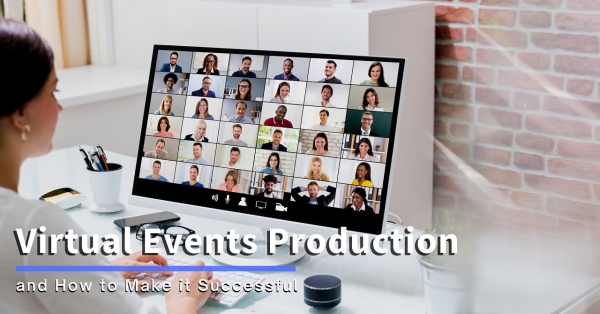What is a Virtual Event?
Virtual events, by definition, are events where guests or participants interact in an online environment. It consists of a host in charge of overseeing the program, a keynote speaker, and an audience.
Currently, virtual events are the prime alternative to physical events due to gathering restrictions. Going live online is how the events industry has adapted to provide its audience with new content and experiences. According to CVENT, an events technology provider, there are four main types of virtual events listed below:
1. Webinars
Webinars are the shortest type of virtual event that usually lasts for 45 to 80 minutes. Around the world, virtual attendees register and tune in to listen as one or more keynote speakers present about the content topic. Webinars also use conferencing tools that allow a Q&A session where the audience may interact, present live and pre-recorded content, and a recording offered after. Due to its accessibility and one-off nature, webinars produce the most number of virtual attendees.
2. Virtual Conferences
Virtual conferences are just like physical conferences. It still has the same structure composed of keynote topics, speakers, and breakout sessions; with the difference of being conducted online. Like webinars, it also uses online technology tools to engage with the audience and include multi-levelled contents. It is not as effective in generating leads and networking as a physical conference. But attendees of virtual events may still interact in real-time, present their network, and build connections with other attendees.
3. Internal Hybrid Events
As discussed in our previous blog about Hybrid Events, it combines both physical and virtual events. Internal hybrid events within a single organisation where its members are not in a single location. It applies to companies that have presence across the globe that need to disseminate centralised information more efficiently. It also works best to keep the communication line open for all parties and keep them posted without the additional cost and stress of scheduling an in-person meeting.
4. External Hybrid Events
Lastly, external hybrid events are events that reach outside an organisation. Industry giants typically conduct hybrid events for product launches or market introduction. It requires seamless back-and-forth between the physical venue and the online platforms.
Things to Prepare for your Virtual Event

When preparing for a virtual event, a lot of the work starts behind the scenes. It takes weeks to even months before the event proper. These collaterals act as the primary tools for promotion, data gathering, and programme planning. Listed below are some of the things you would have to prepare for your virtual event:
Event Website and Registration
The event website is the primary tool used to promote your event. It would attract interested people and get them to register for your event. The content of the event website should be able to communicate what the event is about, the schedule, related programme, the speakers and some FAQs. It has well-written scripts about the event, the inclusion, background of speakers, and programmes promoting the value of the event. It is also important to Include banners and logos as well to make your website visually attractive.
Once you have set up your event website, make sure to include links for registration. It makes it easier for the viewers to sign up for your event once they view it. Registrations would act as data collection and critical for creating your leads. It helps event planners and marketers measure market demand, build lists, generate sales, and ensure event success.
Event Advertisement
Intensive marketing and advertising are crucial for any event. It introduces your event to the public and creates traction for your website. An event website would not serve its purpose if not promoted to interested individuals.
Creating advertisement campaigns starts with identifying your target audience and your current community demographic. It allows you to cater your services and content to your primary audience that establishes their loyalty to the brand. Once guaranteed, expect constant content engagement and expanded reach.
You may choose to create Instagram campaigns by planning a series of contents related to your event. Perhaps use the same collaterals and optimise them for Facebook. This way, you would have multiple avenues where you promote the event. Other options are using Google Ads and integration to promote the event through ad placements and website clicks. Remember to research keywords and optimise your event website for SEO. All of this creates a broader reach for your event.
Email Marketing
Apart from social media marketing, search engine optimisation and marketing, email marketing is an effective way to generate leads. Although often overlooked, email marketing builds communication between your brand and potential clients. Marketing through email is more profound and extensive as it requires more attention to details and write-ups. It drives event demand, increases website clicks, and promotes participant registration.
Furthermore, email allows you to communicate with your list at all stages of your event. Starting from event introduction, 1-week to D-Day reminders, and feedback. Use Email Service Providers (ESPs) — email marketing tools that optimise sending out emails to deliver branded and personalised emails to your lists. Automation and analytics of open rates and clicks are also measures for evaluation.
Tips to Make a Virtual Event a Success

Prepare a Programme
A well-written programme flow streamlines the event. Programme flows include allotted time for each segment, breaks, breakout rooms and space for questions. It helps in pacing and ensuring that the event is on track and finishes on time. Respecting everyone’s time is a must.
In creating programmes for your events, ensure that the allotted time is sufficient. Allow space for tech checks and breaks. You have to take time to identify possible issues so you know how to mitigate them. You may also choose to prepare pre-recorded content to show at the start or as ice breakers in-between segments. Going 100% live for virtual events is risky. Pre-recorded contents act as contingencies in case of technical issues, glitches, or crashes. It avoids awkward moments as well as liven up the event atmosphere. A programme also ensures that you end on time. Time is gold. A deviation in your event wastes both your and your guest's time. It is also unprofessional to go over the scheduled time.
Keep Audience Engagement
Audience engagement is essential in virtual events. Considering that there are no non-verbal queues, virtual events are more prone to dead-air. And dead-air is time wasted and loss of engagement. It creates pitfalls in your programme that would make the experience unsatisfactory.
Keep audience engagement by employing live polls and live Q&A. Send call-to-actions for the audience to chat and build rapport. It takes a great host to keep and maintain the audience's attention. If you are a speaker and you have a trusted host, it lessens the burden on your part concerning back end control. A host would be responsible for sending out live chats or posting questions. This way, the speaker can focus on connecting with the audience. Also remember to look at your webcam to engage with your audience. If you keep looking down at your keyboard, your audience may get turned off no matter how good your content is.
Other ways to get your audience engaged is utilising hashtag events or encouraging them to take photos of the event. Urge them to post their takeaways on their social media accounts. It would make your audience feel like they are part of an online community and promote your event.
Create a Conducive Environment
Creating a conducive environment for hosting your virtual events keeps your event professional. Some people would think that this is unnecessary and requires additional cost. But if you want to build your brand and provide quality events, it is an investment.
Make sure that your place has minimal to no noise. Create your own professional space by ensuring that the background is clean, there is no clutter, and that the setting is well-lit. Use ring lights or at least find a good spot with natural lighting. In addition, it helps to have a virtual background and invest in green screen backdrops if you think that you would be doing a lot of virtual events. If you are not living alone, make sure that everyone in your household is informed of your schedule to avoid disruptions. Dress up and make sure that everything is suitable for the kind of event you are attending; do you have to be in formal clothes or is casual clothing enough?

Perform Technical Checks and Rehearsals
Just like creating a live physical event programme, technical checks and rehearsals help in streamlining your event. It keeps the host and the speaker informed about the event flow. It also conditions you to keep your focus on the event and avoid distractions. Rehearsals also serve as a warm-up so that everyone is ready and it creates the overall atmosphere.
Technical checks in hosting a webinar also include going through possible network issues to avoid. Check all the presentation slides and videos. Perform audio tests and check the mic and speakers. Prepare the questions beforehand and practice for the live polls. Perform technical checks at least 30 minutes before a virtual event. But if you can allocate more time, the better!
Provide Feedback Forms and Consolidating Questions
As mentioned, virtual events lack the usual non-verbal queues that in-person events have. It makes it difficult for the speakers and the hosts to gauge reactions and assess audience feedback. Therefore using feedback tools and sending post-event surveys help in measuring its success. Feedback would also help in determining which aspects of your events need improvement to provide better services moving forward.
Consolidating the questions asked during the event does not only ensure everything was addressed, it also provides virtual leads that assess what your audience interests and what other services they might need. You may include these consolidated questions with respective answers in your newsletters or event recordings.
Dolce Vita could help you streamline your presentation and show your expertise through our proven system of hosting webinars. You may contact This email address is being protected from spambots. You need JavaScript enabled to view it. for more details. Or check out our webinar hosting package at Dolce Vita Webinar Hosting Service.

